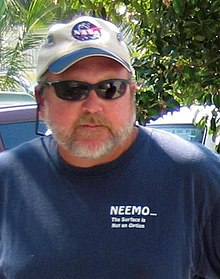| Mark Hulsbeck | |
|---|---|
 Mark Hulsbeck in 2007 Mark Hulsbeck in 2007 | |
| Born | Mark Whitney Hulsbeck (1956-02-20) February 20, 1956 (age 68) Cincinnati, Ohio |
| Nationality | American |
| Alma mater | University of South Florida |
| Occupation | Professional aquanaut |
Mark Whitney Hulsbeck (born February 20, 1956) is an American professional aquanaut. He serves as an Oceanographic Operations Field Manager and research diver for the Aquarius Reef Base, the world's only undersea research laboratory, operated by Florida International University. Hulsbeck is nicknamed "Otter".
Early life and career
Hulsbeck was born in Cincinnati, Ohio, and grew up in Venice and Orlando, Florida. He served in the United States Navy for five years as a helicopter rescue aircrewman. He subsequently earned a degree in geology from the University of South Florida. Hulsbeck then joined the National Oceanic and Atmospheric Administration Commissioned Corps, in which he served as Navigation Officer on the NOAA ship Malcolm Baldrige during its circumnavigation of the Earth. Hulsbeck's professional qualifications include a United States Coast Guard Captain's license. He is also a Professional Association of Diving Instructors Master Scuba Diver Trainer, an International Association of Nitrox and Technical Divers Nitrox Instructor, a Divers Alert Network Oxygen Instructor and a Dive Medical Technician.
Aquarius and NEEMO

In October 2001, Hulsbeck took part as a habitat technician in the NASA Extreme Environment Mission Operations 1 mission (NEEMO 1), the first of a series of NASA-NOAA missions which use Aquarius as an analog environment for space exploration. The NEEMO 1 crew lived and worked underwater aboard Aquarius for seven days. In July 2006, Hulsbeck served as a habitat technician during the NEEMO 10 mission, the crew of which also lived underwater for seven days. Hulsbeck's other missions aboard Aquarius have included a June 2004 coral reef study led by Dr. James Leichter of the Scripps Institution of Oceanography and an October 2007 mission studying the role of sponges in coastal nitrogen cycles. Hulsbeck had taken part in nineteen Aquarius missions as of July 2011. In June and July 2014, Hulsbeck served as lead habitat technician aboard Aquarius during Fabien Cousteau's Mission 31 expedition, living and working underwater for 31 days.
In May 2007, Hulsbeck and other NURP/UNCW divers, including fellow Aquarius divers James Talacek and Jim Buckley, set up a coral monitoring station pylon offshore from the Discovery Bay Marine Laboratory in Discovery Bay, Jamaica, for a cooperative program among Caribbean countries called Mainstreaming Adaptation to Climate Change (MACC). The station was part of NOAA's Integrated Coral Observing Network (ICON). The station was subsequently destroyed during Hurricane Paloma in November 2008.
Personal life
Hulsbeck enjoys reading, diving and boating. He is married with three children and a son from a previous marriage.
Publications
- Bohnsack, James A.; Sutherland, David L.; Harper, Douglas E.; McClellan, David B.; Hulsbeck, Mark W.; Holt, Christopher M. (1989). "The Effects of Fish Trap Mesh Size on Reef Fish Catch Off Southwestern Florida" (PDF). Marine Fisheries Review. 51 (2): 36–46. Retrieved March 27, 2012.
- Sutherland, David L.; Bohnsack, James A.; Harper, Douglas E.; Holt, Christopher M.; Hulsbeck, Mark W.; McClellan, David B. (1991). "Preliminary Report, Reef Fish Size and Species Selectivity by Wire Fish Traps in South Florida Waters" (PDF). Proceedings of the 40th Gulf and Caribbean Fisheries Institute: 108–125. Retrieved March 27, 2012.
Notes
- U.S. Public Records Index Vol 1 (Provo, UT: Ancestry.com Operations, Inc.), 2010.
- ^ Manzello, Derek; Jankulak, Mike; Gramer, Lew; Hendee, Jim (May 26, 2007). "DBJM1 ICON/CREWS Field Log: May 2007". Retrieved March 23, 2012.
- National Aeronautics and Space Administration (May 8, 2007). "Behind the Scenes : TRAINING Imagery". NASA. Archived from the original on August 1, 2007. Retrieved March 23, 2012.
- Relles, Noelle (August 20, 2009). "All work and no play..." Virginia Institute of Marine Science. Retrieved March 26, 2012.
- Hulsbeck, M W (2011) 'It’s great to be back in Aquarius for another mission! | Aquarius'. https://aquarius.fiu.edu/press-1/news/2011/its-great-to-be-back-in-aquarius-for-another-mission/
- Aquarius (2016) 'Mark Hulsbeck | Aquarius'. https://aquarius.fiu.edu/contacts/mark-hulsbeck/
- "Aquarius - Mark Hulsbeck". University of North Carolina Wilmington. August 2000. Archived from the original on 2012-12-15. Retrieved March 24, 2012.
- ^ "Profiles - NOAA's Aquarius Reef Base". University of North Carolina Wilmington. July 2011. Archived from the original on 2012-12-12. Retrieved March 24, 2012.
- NASA (February 27, 2006). "Behind the Scenes: Training - NEEMO History". NASA. Archived from the original on July 15, 2003. Retrieved March 23, 2012.
- NASA (2006). "NASA Uses Undersea Lab to Prep for Future Space Exploration". NASA. Retrieved March 21, 2012.
- NASA (July 22, 2006). "NASA - NEEMO 10 Mission Journal". NASA. Retrieved March 21, 2012.
- Aquarius (2016) 'News | Aquarius'. https://aquarius.fiu.edu/press-1/news/2016/#nasa-conducts-day-mission-in-preparation-of-neemo-21
- "Aquarius Aquanauts Dive Deep and Long to Study Coral Reefs in Florida". University of North Carolina Wilmington. June 15, 2004. Archived from the original on December 11, 2012. Retrieved March 24, 2012.
- "Mission Blog - Mission & Project Info - NOAA's Aquarius Reef Base". National Undersea Research Center. October 2007. Archived from the original on May 2, 2012. Retrieved March 26, 2012.
- Dujmovic, Anne (June 1, 2014). "Deep thoughts from aquanauts: Meet the Mission 31 undersea team". CNET. Retrieved July 11, 2014.
- "NOAA - ICON - DBJM1 - Station-Home". National Oceanic and Atmospheric Administration. Retrieved March 23, 2012.
- Hendee, Jim; Gramer, Lew; Manzello, Derek; Jankulak, Mike (December 16, 2008). "DBJM1 ICON/CREWS Field Log". Retrieved March 23, 2012.
External links
- Aquarius bio (2011)
- Aquarius bio (2000)
- Video of Hulsbeck explaining technology used by aquanauts on YouTube
- 1956 births
- Living people
- American underwater divers
- Aquanauts
- National Oceanic and Atmospheric Administration personnel
- People from Cincinnati
- People from Orlando, Florida
- People from Venice, Florida
- United States Navy sailors
- University of North Carolina at Wilmington people
- University of South Florida alumni